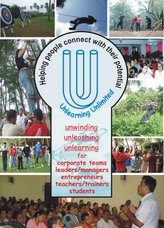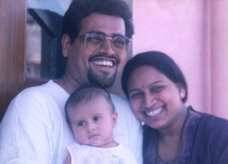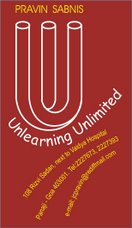The annual general body of the Parent Teachers Association provides occasion to voice concerns. At my daughter’s school, a parent, Mr. Zaidi spoke on the threatening trepidation of terrorism. He made a pertinent point that terrorists were not just those who endangered lives… they included all those whose diminutive acts led to eventual destruction and devastation.
Zaidi spelt out the seemingly innocuous acts that paved the path to peril. Motorists who exceeded speed limit restrictions endangered the safety of the bridge and therefore they were indulging in terrorism. Citizens who did not participate in the responsible management of garbage were pushing society to a deadly epidemic and hence they were fostering a terrorist act. Similarly, environment polluters were jeopardizing lives and foisting terrorism.
Zaidi’s analysis made a pertinent point. Terrorism arises in a self-centred mind clouded by a criminal contempt for collective responsibilities… where narrow motives eclipse the common good. Every time, we involve in acts that eventually lead to the endangerment of lives, we are becoming active contributors to the inhuman acts of terrorism. More often than not, it is the governing authorities and promoters of irresponsible and self-interested ‘development’ that contribute to the build-up of deadly acts of destruction.
However, it is not enough to be a good person… we must be better at ensuring zero tolerance for all acts that lead to eventual terrorism. We must ask ourselves: Do we directly or indirectly support those who in the name of development wreck destruction of lives, lands and livelihoods? Do we overtly or covertly support religious fundamentalists who use the cloak of spiritualism to promote hate and contempt that eventually leads to rioting and violence? Or do we just stand and stare in insensitive indifference?
To BE BETTER at tackling the menace of terrorism…
Let’s connect citizenship with responsive humanism!
- Pravin K. Sabnis
Monday, October 19, 2009
Monday, October 12, 2009
EMPATHY
Our ability to connect with another’s predicament can vary from insensitive indifference to responsive understanding called empathy. Empathy is distinct from pity, sympathy and emotional contagion. Pity is ‘feeling sorry’ for someone in trouble and in need of help. Sympathy is feeling compassion or concern for another, the wish to see them better off or happier. Emotional contagion is when we imitatively 'catch' the emotions that others are showing without necessarily recognizing this is happening.
In 1993, just before Diwali, the Latur earthquake uprooted lives, families and homes. All of us felt pity and sympathy for the affected people. Some of us joined the emotional contagion of donating money and material. But the most valuable lesson came from the families who chose to scale down Diwali celebrations to the bare minimum… as they would have if tragedy were to strike their own home. The money was instead spent for relief work.
Andre Gide queried aptly, ‘Are you then unable to recognize unless it has the same sound as yours?’ Empathy is about recognizing the ‘sound’ of another’s experience even if it is unlike any of ours. It is about putting oneself into the psychological frame of reference of another, so that the other person’s feelings, thinking and actions are understood.
However, empathy should not be an occasional emotion… to be unravelled only in times of great tragedy. For instance, we cuddle contradictions if we practise empathy as a response to ecological calamities while ignoring the fact that they are a result of man-made decisions that trigger the disaster. Hence, we must hear the ‘sounds’ of struggle of people who strive to save their lives, lands and livelihoods. Real empathy is about consistency in our actions to be responsible and responsive human beings.
To BE BETTER at the attitude of empathy…
Let’s move beyond situational sympathy!
- Pravin K. Sabnis
In 1993, just before Diwali, the Latur earthquake uprooted lives, families and homes. All of us felt pity and sympathy for the affected people. Some of us joined the emotional contagion of donating money and material. But the most valuable lesson came from the families who chose to scale down Diwali celebrations to the bare minimum… as they would have if tragedy were to strike their own home. The money was instead spent for relief work.
Andre Gide queried aptly, ‘Are you then unable to recognize unless it has the same sound as yours?’ Empathy is about recognizing the ‘sound’ of another’s experience even if it is unlike any of ours. It is about putting oneself into the psychological frame of reference of another, so that the other person’s feelings, thinking and actions are understood.
However, empathy should not be an occasional emotion… to be unravelled only in times of great tragedy. For instance, we cuddle contradictions if we practise empathy as a response to ecological calamities while ignoring the fact that they are a result of man-made decisions that trigger the disaster. Hence, we must hear the ‘sounds’ of struggle of people who strive to save their lives, lands and livelihoods. Real empathy is about consistency in our actions to be responsible and responsive human beings.
To BE BETTER at the attitude of empathy…
Let’s move beyond situational sympathy!
- Pravin K. Sabnis
Monday, October 5, 2009
ART OF DYING
“I have seen two types of persons... some die silently, others die shouting… and now I saw the third kind” – from the film ‘Rang de Basanti’
When he was born on 17 February 1930 in Calicut, Kerala, the astrologers refused to cast a horoscope for him. They predicted that he would die soon. But Basava Premanand went on to live an inspirationally great life of 80 years till he died on 4 October 2009 at his residence in Podnur, Tamil Nadu.
In the 1940s, Premanand quit school to take part in Quit India Movement. He spent the next 7 years in the newly started Sri-Steila Gurukula. He started the Indian Committee for scientific investigation of Claims of the Paranormal; moved around India explaining the tricks behind miracles and superstitious psychic phenomena and founded FIRA (Federation of Indian Rationalist Associations) which has more than 68 organizations in 26 states in India. Besides authoring 36 books, he also edited the monthly ‘Indian Skeptic’ with articles on the scientific investigation of apparently paranormal occurrences.
Premanand has conducted workshops explaining about 150 miracles from different parts of the world. British film maker, Robert Eagle shot Premanand displaying and teaching many supposedly supernatural stunts such as levitation, flesh piercing and live burials in his documentary, "Guru Busters". He was given a fellowship of National Council for Science and Technology Communication (NCSTC) for his efforts to spread scientific awareness.
In 2006, Premanand was diagnosed to be on the threshold of death due to extreme cancer of the stomach. Though doctors insisted on an emergency operation, Premanand went off instead to search for a contractor to build his dream project - a museum on Method of Science. He handed over the money and came back for an operation that was unable to negate the shadow of death. Yet, Premanand’s enthusiasm never diminished and the project was inaugurated on 5 March 2009 in Podnur.
As his health worsened, Premanand’s detractors began a malicious campaign that he had renounced his rationalism. The fiery sceptic called for his colleagues, Dr Narendra Nayak and Somu Rao and wrote a “declaration of attitude and temperament’ wherein he challenged the rumours and urged his colleagues in the movement to keep working for the cause of rationalism and humanism.
The news of an impeding death has frozen dreams in many a mind… people get sentimental and indulge in worrying… they look at smaller concerns, most surrounding self-interests… tough personalities slow down after being told that they possess some life threatening ailment. But undoubtedly, Premanand has taught us the art of dying… of never giving up on living!
Premanand has shown us the way to BE BETTER at the art of living…
We must move on faster with our life’s dreams when pursued by dying!
- Pravin K. Sabnis
When he was born on 17 February 1930 in Calicut, Kerala, the astrologers refused to cast a horoscope for him. They predicted that he would die soon. But Basava Premanand went on to live an inspirationally great life of 80 years till he died on 4 October 2009 at his residence in Podnur, Tamil Nadu.
In the 1940s, Premanand quit school to take part in Quit India Movement. He spent the next 7 years in the newly started Sri-Steila Gurukula. He started the Indian Committee for scientific investigation of Claims of the Paranormal; moved around India explaining the tricks behind miracles and superstitious psychic phenomena and founded FIRA (Federation of Indian Rationalist Associations) which has more than 68 organizations in 26 states in India. Besides authoring 36 books, he also edited the monthly ‘Indian Skeptic’ with articles on the scientific investigation of apparently paranormal occurrences.
Premanand has conducted workshops explaining about 150 miracles from different parts of the world. British film maker, Robert Eagle shot Premanand displaying and teaching many supposedly supernatural stunts such as levitation, flesh piercing and live burials in his documentary, "Guru Busters". He was given a fellowship of National Council for Science and Technology Communication (NCSTC) for his efforts to spread scientific awareness.
In 2006, Premanand was diagnosed to be on the threshold of death due to extreme cancer of the stomach. Though doctors insisted on an emergency operation, Premanand went off instead to search for a contractor to build his dream project - a museum on Method of Science. He handed over the money and came back for an operation that was unable to negate the shadow of death. Yet, Premanand’s enthusiasm never diminished and the project was inaugurated on 5 March 2009 in Podnur.
As his health worsened, Premanand’s detractors began a malicious campaign that he had renounced his rationalism. The fiery sceptic called for his colleagues, Dr Narendra Nayak and Somu Rao and wrote a “declaration of attitude and temperament’ wherein he challenged the rumours and urged his colleagues in the movement to keep working for the cause of rationalism and humanism.
The news of an impeding death has frozen dreams in many a mind… people get sentimental and indulge in worrying… they look at smaller concerns, most surrounding self-interests… tough personalities slow down after being told that they possess some life threatening ailment. But undoubtedly, Premanand has taught us the art of dying… of never giving up on living!
Premanand has shown us the way to BE BETTER at the art of living…
We must move on faster with our life’s dreams when pursued by dying!
- Pravin K. Sabnis
Subscribe to:
Comments (Atom)



